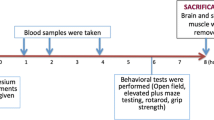Abstract
A 2 x 2 x 3 factorial experiment was conducted to study the pH dependence of a silicon-iron interaction in vivo. The dietary treatments used in the factorial design were the following (mg/kg of diet): silicon, 0 and 500; iron, 35 and 187; acid-base, ammonium chloride as 0.5% of total diet (acidic), sodium bicarbonate as 1.0% of total diet (basic), or no supplementation of acid or base (control). The supplementation of 500 mg silicon/kg of diet increased plasma-iron concentration in rats fed the acidic or control diets, but not in rats fed the basic diet. A high dietary-iron level suppressed copper absorption and utilization and subsequently imposed a negative effect on its own utilization. An increase in the plasma total-cholesterol concentration caused by high dietary-iron level was likely a consequence of the antagonistic effect of iron on copper absorption and utilization. The use of cupric sulfate pentahydrate as the dietary-copper source in this study resulted in plasma copper concentrations that were approximately twice those obtained in a related study using cupric carbonate. Also, a 42% coefficient of variation (C.V.) for plasma-copper concentrations of rats fed cupric sulfate in this study was greatly reduced from the C.V. = 108% previously associated with the dietary cupric carbonate.
Similar content being viewed by others
References
E. D. Harris, Iron-copper interactions: some new revelations,Nutr. Rev. 52, 311–319 (1994).
X. Jia, R. J. Emerick, and H. Kayongo-Male, Biochemical interactions among silicon, iron and ascorbic acid in the rat,Biol. Trace Elem. Res., this issue.
W. R. Humphries, M. Phillippo, B. W. Young, and I. Bremner, The influence of dietary iron and molybdenum on copper metabolism in calves,Brit. J. Nutr. 49, 77–86 (1983).
J. T. Salonen, K. Nyyssonen, H. Korpola, J. Tuomillehto, R. Seppanen, and R. Salonen, High stored iron levels are associated with excess risk of myocardial infarction in eastern Finnish men,Circulation 86, 803–811 (1992).
J. L. Sullivan, Iron and the sex difference in heart disease risk,Lancet 1, 1293–1294 (1981).
G. K. Davis and W. Mertz, Copper, inTrace Elements in Human and Animal Nutrition, W. Mertz, ed., 5th ed., Academic Press, San Diego, CA (1987).
K. G. D. Allen, S. Kim, and S. D. Clarke, Dietary copper (Cu) deficiency increases hepatic 3-hydroxy-3-methylglutaryl coenzyme A reductase activity and mRNA level,FASEB J. 9, A733 (1995).
R. K. Iler,The Chemistry of Silica, John Wiley & Sons, New York (1979).
L. L. Olson and C. R. O’Melia, The interactions of Fe(III) with Si(OH)4,J. Inorg. Nuclear Chem. 53, 1977–1985 (1973).
R. J. Emerick and H. Kayongo-Male, Interactive effects of dietary silicon, copper, and zinc in the rat,J. Nutr. Biochem. 1, 35–40 (1990).
S. R. Stewart, R. J. Emerick, and H. Kayongo-Male, Silicon-zinc interactions and potential roles for dietary zinc and copper in minimizing silica urolithiasis in rats,J. Anim. Sci. 71, 946–954 (1993).
A. D. Olson and W. B. Hamlin, A new method for serum iron and total iron-binding capacity by atomic absorption spectrophotometry,Clin. Chem. 15, 438–444 (1969).
H. P. Lehmann, K. H. Schosinsky, and M. F. Beeler, Standardization of serum ceruloplasmin concentrations in international enzyme units with O-dianisidine dihydrochloride as substrate,Clin. Chem. 20, 1564–1567 (1974).
SAS,SAS/STAT Guide for Personal Computers, Version 6 ed., SA Institute Inc., Gary, IN (1985).
Y. Charnot and G. Peres, Silicon, endocrine balances and mineral metabolism (calcium and magnesium), inBiochemistry of Silicon and Related Problems, G. Bendz and I. Lindqvist, eds., Plenum Press, New York (1978).
S. Kim, P. Y. Chao, and K. G. D. Allen, Inhibition of elevated hepatic glutathione abolishes copper deficiency cholesterolemia,FASEB J. 6, 2467–2471 (1992).
K. G. D. Allen and L. M. Klevay, Copper deficiency and cholesterol metabolism in the rat,Atherosclerosis 31, 259–271 (1978).
E. R. Morris, Iron, inTrace Elements in Human and Animal Nutrition, W. Mertz ed., 5th ed., Academic Press, San Diego, CA (1987).
E. B. Dawson, M. J. Frey, T. D. Moore, and W. J. McGanity, Relationship of metal metabolism to vascular disease mortality in Texas,Am. J. Clin. Nutr. 31, 1188–1197 (1978).
P. G. Reeves, F. H. Nielsen, and G. C. Fahey, Jr., AIN-93 purified diets for laboratory rodents: final report of the American Institute of Nutrition Ad Hoc writing committee on the reformulation of the AIN-76A rodent diet,J. Nutr. 123, 1939–1951 (1993).
Author information
Authors and Affiliations
Rights and permissions
About this article
Cite this article
Jia, X., Emerick, R.J. & Kayongo-Male, H. The pH dependence of siliconiron interaction in rats. Biol Trace Elem Res 59, 113–122 (1997). https://doi.org/10.1007/BF02783236
Received:
Accepted:
Issue Date:
DOI: https://doi.org/10.1007/BF02783236




